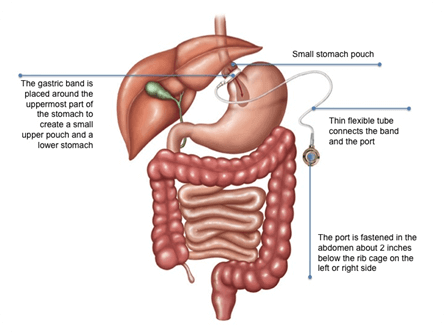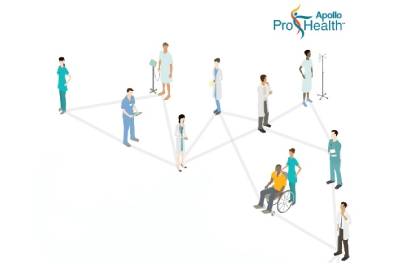Laparoscopic Adjustable Gastric Banding (LAGB)
What is Laparoscopic Adjustable Gastric Banding?
Laparoscopic adjustable gastric banding (LAGB) or Laparoscopic Gastric banding is one of the least invasive weight loss surgery options. LAGB is performed as a laparoscopic surgery, with just a few small abdominal incisions, rather than one large cut. An adjustable band is put around the stomach to create a small pouch; thus you feel full even after eating a small quantity of food. The band can be tightened or loosened by your doctor by injecting or removing fluid into the port.
Why is it done?
Laparoscopic adjustable gastric banding is a weight loss surgery, suggested for individuals who have:
- Tried non-surgical weight loss methods (such as dietary changes, medications etc.) without any long-term success.
- BMI is greater than 40.
- BMI is 35 with obesity related complications such as type 2 diabetes.
What happens during the procedure?
The procedure will be performed under general anaesthesia. Your surgeon will make small incision and insert instruments through theseincisions. Your surgeon will place an adjustable band around the upper part of your stomachand tighten it to form a small pouch. This creates a narrow passage for the food to move from the upper small pouch to the lower larger part of the stomach. A tube will be attached to the adjustable band. This tube is accessible through a port which is secured under the skin of your abdomen. Once procedure is completed, the incision site will be closed.

How long will it take?
The procedure usually takes 30 – 60 minutes depending upon your condition.
What happens after the procedure?
Post-surgery, you will be encouraged to walk to prevent blood clots. You will be given fluids and then be put on pureed food. Laparoscopic adjustable gastric banding generally requires 1 or 2 days stay at the hospital. You will be under a special diet which has to be followed strictly.Laparoscopic adjustable gastric banding limits the quantity of food that your stomach can hold, hence you don’t feel hungry even after eating only small amounts of food.Due to the narrow opening, food stays in the pouch for a longer time and you will also feel satisfied. This causes weight loss. However, this doesn’t reduce the absorption of calories and nutrients.Being an adjustable gastric band,your doctor might inject saline to make the band tighter or take out saline to loosen the band. Your weight loss and health condition will also be monitored on an out-patient basis.
Apollo expertise in the procedure
Apollo Hospitals is one of the few hospitals to perform over 100 bariatric surgeries which includes Gastric Banding also.
Get in touch
To contact our Bariatric Surgeon, click here
FAQs
What are advantages of Gastric Banding?
- Faster recovery.
- It is a reversible procedure and does not disturb normal anatomy.
- Band can be adjusted.
- Possibility of long-term weight loss.
- Reduced risk in associated co-morbidities.
- Better quality of life.
How to prepare for Laparoscopic Adjustable Gastric Banding?
- Pre-operativeinvestigations may involve blood tests and ECG as well as routine pre-surgical and pre-anaesthetic clearance tests.
- Don’t eat or drink after midnight.
- Arrange someone to drive you home and for help at home during your recovery period.
- In case you take any medications on regular basis, inform your doctor prior.
What happens after laparoscopic adjustable gastric banding (LAGB)?
LAGB does not make you lose weight suddenly. However, it is considered as safer and minimally invasive procedure when compared to other weight-loss surgeries, including conventional gastric bypass. You’ll have to be prepared to eat appropriately and do exercises. You can expect a long-term weight loss of approximately one fourth to one third of your previous weight before the procedure was done.
What to eat when you go home:
- Your diet will be mostly liquids and pureed food for 2 to 3 weeks.Avoid all fizzy drinks.
- After 4 to 6 weeks, soft foods will be added in your diet.
- You can have a normal diet after 6 weeks. You need to modify your lifestyle by eating smaller meals. Chew your food slowly and properly.
- Take small sips. Don’t gulp your drinks as this may cause vomiting.
- Stop eating when you feel full.
- Eat healthy food, preferably a high protein diet. Avoid having any liquid too close to your meal time.
There are chances that you may have nutritional deficiencies, to avoid this your doctor will prescribe daily supplements as per your requirement. You’ll also need to have regular medical care to watch for any nutritional problems.
UPDATED ON 28/03/2024
Apollo Highlights & Updates
 On World Health Day, Apollo Hospitals has unveiled the 4th edition of the Health of Nation report....
On World Health Day, Apollo Hospitals has unveiled the 4th edition of the Health of Nation report.... Call Us Now
+91 8069991061
Book Health Check-up
Call Us Now
+91 8069991061
Book Health Check-up





